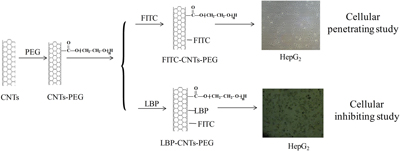Crossref Citations
This article has been cited by the following publications. This list is generated based on data provided by
Crossref.
Jiang, Tingting
Chen, Guangxiang
Shi, Xiangyang
and
Guo, Rui
2019.
Hyaluronic Acid-Decorated Laponite® Nanocomposites for Targeted Anticancer Drug Delivery.
Polymers,
Vol. 11,
Issue. 1,
p.
137.
Saliev, Timur
2019.
The Advances in Biomedical Applications of Carbon Nanotubes.
C,
Vol. 5,
Issue. 2,
p.
29.
Liu, Wei
and
Speranza, Giorgio
2019.
Functionalization of Carbon Nanomaterials for Biomedical Applications.
C,
Vol. 5,
Issue. 4,
p.
72.
Faraji Dizaji, Babak
Khoshbakht, Saba
Farboudi, Amirnezam
Azarbaijan, Mohammadreza Hasani
and
Irani, Mohammad
2020.
Far-reaching advances in the role of carbon nanotubes in cancer therapy.
Life Sciences,
Vol. 257,
Issue. ,
p.
118059.
Wan, Jun
Wang, Jian
Zhou, Min
Rao, Zhanpeng
and
Ling, Xiean
2020.
A cell membrane vehicle co-delivering sorafenib and doxorubicin remodel the tumor microenvironment and enhance immunotherapy by inducing immunogenic cell death in lung cancer cells.
Journal of Materials Chemistry B,
Vol. 8,
Issue. 34,
p.
7755.
De Souza, Leonardo A.
Almeida, Eduardo R.
Belchior, Jadson C.
Dos Santos, Hélio F.
and
De Almeida, Wagner B.
2021.
Cisplatin release from inclusion complex formed by oxidized carbon nanotube: A DFT study.
Chemical Physics Letters,
Vol. 774,
Issue. ,
p.
138619.
Sajjadi, Mohaddeseh
Nasrollahzadeh, Mahmoud
Jaleh, Babak
Soufi, Ghazaleh Jamalipour
and
Iravani, Siavash
2021.
Carbon-based nanomaterials for targeted cancer nanotherapy: recent trends and future prospects.
Journal of Drug Targeting,
Vol. 29,
Issue. 7,
p.
716.
Farmand, Maryam
Jahanpeyma, Fatemeh
Gholaminejad, Alieh
Azimzadeh, Mostafa
Malaei, Fatemeh
and
Shoaie, Nahid
2022.
Carbon nanostructures: a comprehensive review of potential applications and toxic effects.
3 Biotech,
Vol. 12,
Issue. 8,
Ahmadian, Elham
Janas, Dawid
Eftekhari, Aziz
and
Zare, Najme
2022.
Application of carbon nanotubes in sensing/monitoring of pancreas and liver cancer.
Chemosphere,
Vol. 302,
Issue. ,
p.
134826.
Yazdani, Sara
Mozaffarian, Mehrdad
Pazuki, Gholamreza
and
Hadidi, Naghmeh
2022.
Application of Flory-Huggins model in experimental and theoretical study of stability of amphotericin B on nanocarrier based on functionalized carbon nanotube.
Journal of Molecular Liquids,
Vol. 360,
Issue. ,
p.
119519.
Wu, Yinghua
Zhang, Junfeng
He, Wen
Li, Chenchen
and
Wang, Yanli
2023.
Nanomaterials for Targeting Liver Disease: Research Progress and Future Perspectives.
Nano Biomedicine and Engineering,
Vol. 15,
Issue. 2,
p.
199.
Mohan, Hugh
Fagan, Andrew
and
Giordani, Silvia
2023.
Carbon Nanomaterials (CNMs) in Cancer Therapy: A Database of CNM-Based Nanocarrier Systems.
Pharmaceutics,
Vol. 15,
Issue. 5,
p.
1545.
Chary, Padakanti Sandeep
Bhawale, Rohit
Vasave, Ravindra
Rajana, Naveen
Singh, Pankaj Kumar
Madan, Jitender
Singh, Shashi Bala
and
Mehra, Neelesh Kumar
2023.
A review on emerging role of multifunctional carbon nanotubes as an armament in cancer therapy, imaging and biosensing.
Journal of Drug Delivery Science and Technology,
Vol. 85,
Issue. ,
p.
104588.
Zolali, Elmira
Rashedi, Sina
Abdolahinia, Elaheh Dalir
Rashedi, Nasim
Allahyari, Saeideh
and
Hashemzadeh, Nastaran
2023.
Principles of Biomaterials Encapsulation : Volume Two.
p.
589.
Wang, Yingxue
Sun, Chunhui
Liu, Zhaoying
Zhang, Shengmin
Gao, Ke
Yi, Fan
Zhou, Wenjuan
and
Liu, Hong
2024.
Nanoengineered Endocytic Biomaterials for Stem Cell Therapy.
Advanced Functional Materials,
Vol. 34,
Issue. 52,
Rahchamandi, Seyedeh Yasaman Rahnamaei
Mirhadi, Elaheh
Gheybi, Fatemeh
Kazemi-Beydokhti, Amin
Jaafari, Mahmoud Reza
Mostafavi, Ebrahim
Kesharwani, Prashant
Sahebkar, Amirhossein
and
Alavizadeh, Seyedeh Hoda
2024.
Engineering carbon-based nanomaterials for the delivery of platinum compounds: An innovative cancer disarming frontier.
Environmental Research,
Vol. 262,
Issue. ,
p.
119933.
Sameer Khan, Mohammad
Jaswanth Gowda, B.H.
Hasan, Nazeer
Gupta, Garima
Singh, Tanuja
Md, Shadab
and
Kesharwani, Prashant
2024.
Carbon nanotube-mediated platinum-based drug delivery for the treatment of cancer: Advancements and future perspectives.
European Polymer Journal,
Vol. 206,
Issue. ,
p.
112800.
Eivazzadeh-Keihan, Reza
Sadat, Zahra
Lalebeigi, Farnaz
Naderi, Nooshin
Saadatidizaji, Zahra
Maleki, Ali
and
Ahadian, Samad
2024.
Functionalized Nanomaterials for Cancer Research.
p.
459.
Niveria, Karishma
Yadav, Monika
Singh, Priyanka
Dangi, Kapil
Mittal, Disha
and
Verma, Anita K.
2025.
Biomaterials for Precision Cancer Medicine.
p.
425.
